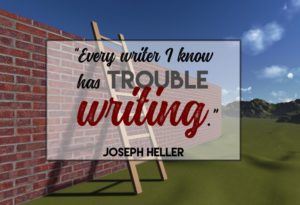3 Essential Ingredients for Successful Writing Instruction
Laura sat in her desk, averting her teary eyes from her peers, as she stared at the oversized, red letter scrawled on the top of her essay — a big, fat C-. She had stayed up until midnight on several occasions revising and editing this paper, making it perfect, or at least she thought. All she had to show for it was an embarrassing grade and some handwritten scrawls, including “You need to show more critical thinking here,” and “incorrect MLA citation format.” Why bother, really, she wondered?
These thoughts are all from Laura’s viewpoint, of course. Laura’s teacher may have spent an hour grading her paper, providing constructive feedback and trying to help her grow as a writer, but Laura’s interpretation of her value as a writer was hyper-focused on what was wrong with her work. Writing is extremely personal. Most people can vividly remember negative feedback on essays they’ve written in their past, for school, personal, or business purposes. I know I certainly can. It stings. And it usually sticks with us longer than praise, regardless of the teacher’s intentions.
That’s my focus when I think about my philosophy for teaching and grading writing. I ask myself questions like, How can I create an environment in which students grow in their writing abilities? What can I do to help students develop confidence in their own talents as writers?
Three essential answers to these questions can form the foundation of a teacher’s philosophy for writing instruction and assessment in the classroom. Over the past decade, my failures and triumphs in respect to these cornerstones have shaped my beliefs about teaching writing.

Cornerstone 1: Make it Enjoyable
1. Use writing surveys. At the beginning of the year or semester, I like to explore my students’ backgrounds with writing (experiences they had prior to walking through my door). Doing this helps me design and tailor my instruction appropriately. It also makes me sensitive to the raw, emotional experiences of my students. If you don’t yet have one, I’d be happy to share mine.
2. Provide choice. Giving students a choice in writing topics is a game-changer. Actually, I never really thought it would make much of a difference until I began noticing year after year that students were usually assigned topics. One year, I remember all of my students saying they had only written one essay the previous year, and it was about dodgeball. Can you imagine reading and grading 150 essays about dodgeball? I think it would be a fair assumption that all 150 students didn’t enjoy that topic, either. In regards to letting students pick their topics, I generally allow more freedom based on age and ability level. In the past, I’ve noticed that struggling writers can become paralyzed when told to “go pick a topic,” so I give them a list from which to choose.
3. Make writing a social experience. Students are social beings by nature. Teachers can capitalize on this strength by allowing students to collaborate on essays or to help one another select topics, revise essays, create titles, and learn how to talk about writing in general.
4. Differentiate genres of writing. Students all have different interests and strengths as writers. I like using projects like the multi-genre research project because I can require all students to include a research paper, but beyond that, they can explore their topic in a student-driven fashion by determining what other genres of writing will help to convey their information most appropriately.
5. Use analogies, metaphors, and kinesthetic activities. We’ve all heard of the hamburger or sandwich analogy for paragraph writing. It’s a pretty standard comparison. Why? It’s effective! Using manipulatives and metaphors (both teacher- and student-created) will make the writing process more enjoyable for students, and they will master the concepts quicker.
6. Model writing for students. Over the years, I’ve noticed increased engagement and enjoyment with writing assignments when I model my expectations in front of students. Sometimes I do this as a “think aloud,” but other times, I involve the class. We write an example together. It’s powerful, and usually, everyone is attentive. It takes the pressure off of those who are self-conscious about their own writing abilities, but they are still learning by example.

Cornerstone 2: Scaffold Instruction
1. Use pre- and post-tests. When I think about how to scaffold writing instruction, I always begin by designing a pre-test and post-test that is authentic to what I want my students to be able to do at the culmination of that unit or of our time together. If, for example, I want my students to be able to write an argumentative research paper, I will design a pre-test prompt with a standard question and also provide them with a source to cite in the essay. I never take pre-tests for a grade, although I do assess them so that I have a basis for measuring growth. Whatever I use as the pre-test, I actually use the exact same prompt and article as the post-test. In my mind, this consistency allows for the most accurate depiction of how much students learned during the unit.
2. Differentiate rubrics. Something I’ve found extremely successful with my mixed ability classes is to differentiate rubrics for the same essay. While many people would expect an uproar, my students are surprisingly receptive to the idea that we are all created differently, and just as not all of us need reading glasses or braces, each of us has various academic needs as well. They realize their teacher has each student’s best interests in mind and that the assignment is geared to their readiness levels.
3. Conference with individuals and groups. Meeting both with individual students about their essays as well as with small groups is imperative. When students are grouped based on common areas for improvement, it’s easy to host a five or ten minute minilesson that pertains exactly to what those students need. If the door of honest communication is open throughout the essay-writing process, fewer students are surprised when they received a graded final essay from the teacher.
4. Use a building blocks approach. With my writing instruction, I start simple and progress to more advanced concepts, both for the length of the assignment and the skills emphasized. At the beginning of a research unit, I assign research sentences, and by the end, students are writing essays. By tailoring assignments to my students’ zones of proximal development, they aren’t frustrated and overwhelmed by the writing assignment. This approach creates less of a headache for teachers as well.
5. Make expectations clear. I give students the rubric when I assign the essay. That way, they know exactly what my expectations are from Day One. I also provide them with sample essays to assess using the same rubric. We have discussions about the strengths and weaknesses of each essay so that students are comfortable in knowing how to succeed. Another way I clarify expectations is through frequent feedback. Depending on the unit and the assignment, I might do any or all of the following: provide feedback during class revision sessions, hold short conferences about students’ drafts, leave them comments on Google Docs, or collect one paragraph at a time and hand it back with ideas before students move on to the next part of the assignment.
6. Allow for revision. The most important takeaway to me during a writing unit is that students learn from the comments I give them. What’s the point of spending 30 minutes grading a paper only to hand it back and watch students recycle it before even reading the comments? Students enjoy reading feedback and learning about writing when they know it’s okay to make mistakes on a rough draft. That’s not to say I let my kiddos turn in slop for a rough draft. No way! They know that doesn’t fly. If I feel a student hasn’t given their best effort, I hand it back before commenting and ask them to resubmit by a set date. When allowing students to revise, I believe it’s important to do so without negatively impacting their grade. Students lose the motivation to improve upon their initial work if they know it won’t help them out much in the grade book.

Cornerstone 3: Be Intentional
1. Determine what students should learn. We shouldn’t enter into an essay unit with a vague goal, like “I want to teach my students how to write an argumentative essay.” Sure, it’s important for students to be able to demonstrate that skill, but I find that honing in on a more specific skill or standard within a genre of writing leads to higher levels of student success. For example, one of the ninth and tenth grade common core writing standards indicates students should be able to “Introduce precise claim(s), distinguish the claim(s) from alternate or opposing claims, and create an organization that establishes clear relationships among claim(s), counterclaims, reasons, and evidence.” Keeping the standard in mind, I might use the argumentative research paper as the vehicle to help students master these particular skills. I focus my instruction before I decide anything about the type or topic of essay by zeroing in on the learning standards and ultimate skills I want students to master.
2. Select a trait of writing. It’s important to focus on traits of writing that students have not yet mastered, which varies by grade level. For instance, I often begin with the concept of developing ideas since many of my students struggle with writing thesis statements and topic sentences. Zeroing in on one trait reduces the odds of inundating students by asking them to complete one skill well instead of six or seven poorly.
3. Begin with familiar genres. Many students have already been introduced to persuasive, narrative, and argumentative writing. I start there to build confidence and trust. As the year progresses, I work up to analytical styles, which are usually more challenging for students.
4. Embed grammar instruction. Teaching grammar through writing (as well as through direct instruction) is possibly the most important crux of my writing philosophy. Understanding the structure and rules of the English language empowers us as writers.
5. Add a new writing technique with each assignment. With the first essay, for instance, I might teach students how to use transitional phrases and dependent clauses. Generally, my students come to me either not using transitions or using the standard, one-word options, like “first,” and “finally.” After I observe that students are demonstrating mastery of using phrases and clauses as transitions, I teach them how to use entire sentences to transition between ideas and paragraphs with their next essay. This approach is simple, scaffolded, and non-intimidating for students.
Teaching writing is no easy task. It’s a process of trial and error. Teachers are always learning and growing from experiences with students as well as from collaboration with others. We may have the best intentions in mind, but to avoid alienating students like Laura, we need to be intentional with our approach to teaching and assessing writing. When students know we care about them as people, that they are more than a letter grade, that they can trust us — that’s when we can help them grow and mature as writers.
Click on the image below to download a free writing survey for secondary students.
